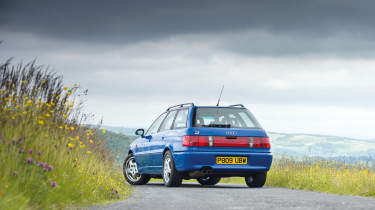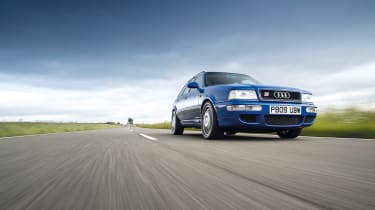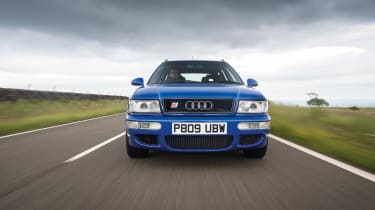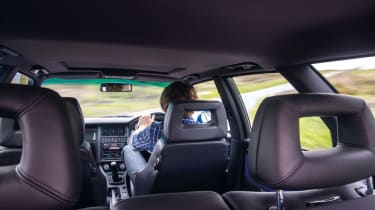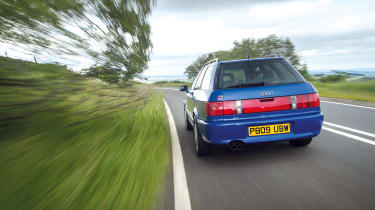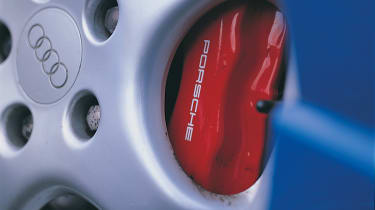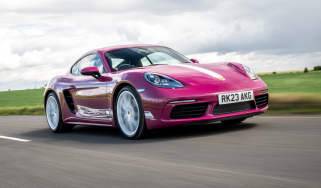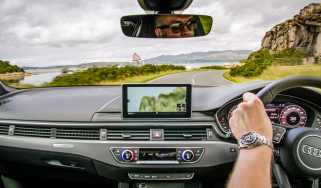Audi RS2 – review, history, prices and specs
Audi’s first RS car set the template for fast Audis to come, and for good reason.
Today, if you said the sixteenth letter of the alphabet followed by the first positive integer to a roomful of car enthusiasts, I suspect most would instantly think of McLaren’s hypercar. And with good reason. Some, however, would undoubtedly think of the Prodrive-tuned GC8 Subaru Impreza. A few might even connect it with the supercar club that Damon Hill helped set up a while ago. But long before all of these there was the Audi RS2, and I think it can reasonably lay claim to having first dibs on the now well-known nomenclature. Why? Because while it was being developed in the early ’90s, the RS2 was known internally at Audi as ‘P1’.
The ‘P’, of course, stood for ‘Porsche’. Ferdinand Piëch, then head of Audi’s supervisory board, realised that his Ingolstadt engineers were far too busy developing the important new A4, A6 and A8 models to be distracted by a niche project like the RS2, but nonetheless he wanted his idea for a really fast estate car to come to fruition. Turning to Porsche, where Piëch had worked during the ’60s and early ’70s, was the obvious solution. Call it payback for Audi building the 924 and 944 for Porsche.
In Detail
Looking around the car, I’m staggered once more by just how many bits are obviously from the Zuffenhausen toy cupboard. The first things that catch my eyes are the wing mirrors. Slightly too small for the car, their 911 shape acts like a catalyst, opening your eyes to all sorts of other Porsche parts. The front bumper, with its indicators and sidelights, is suddenly an obvious refugee, as are the five-spoke 17-inch Carrera Cup wheels, which have such a distinctive Porsche design. Look closer still and you see that the brake calipers actually spell it out for you with the seven white letters on a red background. The name is also there, in even smaller letters, on the badges on the front grille and the tailgate. Interestingly, this first Audi RS badge also separates the ‘R’ from the ‘S2’, denoting that this is very much the Renn version of Audi’s pre-existing S2 model.
The lowlier model had 230bhp and 258lb ft, and although the same basic 20-valve in-line five-cylinder engine remained, Porsche badges greet you once more when you lift up the bonnet on the RS2. Hotter camshafts and a 30 per cent bigger KKK turbocharger puffing at 1.4bar (up from 1.1) were perhaps the biggest changes, although a new Bosch engine management system, new injectors, a more freely flowing exhaust manifold and a bigger intercooler all played their part too. The end result of all this fettling was that Michael Hölscher, who oversaw the project and would go on to work on the Carrera GT, exceeded the target set for him of a 30 per cent increase in power, the final figures reading 315bhp at 6500rpm and 302lb ft at 3000rpm.
> Click here for more on the latest Audi RS4
The now famous Nogaro Blue paint is distinctive but not lairy… unlike the blue Alcantara inside. Open the door and you are exposed to what can only be described as a very arresting interior. The options were full black Nappa leather with wood veneer, silver Alcantara with carbonfibre, or 'the blue'. Initially it’s overwhelming in its vibrancy, but look closer and there are some lovely details, such as the very subtle blue strands that run through the weave of the glossy carbonfibre.
As just 180 units of 2900 came with the wheel on the right-hand side, the RS2 is a rare beast. Incidentally, Audi originally intended to produce only 2200 RS2s, but such was the car’s popularity that it eventually increased that number by 700.
Get in and you find that the Recaro, with its very period rectangular headrest, is set a little high but clasps you reassuringly about the ribcage. Twist the key and the RS2 comes to life with a dry, high-pitched clearing of its throat before settling to a bassy but relatively demure idle. The wheel is quite an attractive airbag item but some of the early cars came with an even simpler looking Procon-Ten three-spoker (Procon-Ten was a cable-operated system that, in the event of a crash, pulled the steering wheel towards the dash while simultaneously tightening the seatbelts).
| Audi RS2 (1994) | |
| Engine | in-line 5-cylinder, 2226cc, turbo |
| Max power | 315bhp @ 6000rpm |
| Max torque | 302lb ft @ 3000rpm |
| Weight | 1595kg |
| Power-to-weight | 201bhp/ton |
| 0-60mph | 5.4sec (claimed) |
| Top speed | 163mph (limited) |
The Drive
With plenty of room in the RS2 there’s no need to banish photographer Aston Parrott to a separate car, so he piles his camera equipment into the boot and we head off onto the Derbyshire roads. We’re heading for the highways and byways around Chatsworth because I rather like the idea of one great rallying estate hosting another. The RS2’s cabin feels wonderfully light and airy as we reach the nearby moorland. All-round visibility would hardly be better if we were in the top of a lighthouse. As we pass the majestic west façade of Chatsworth House, viewed across impeccable rolling parkland that is kept trim by a herd of wandering sheep, I’m sorely tempted to just fulfil all my Quattro-based RAC Rally fantasies and dive off onto the grass to create a special stage between the trees, just as they did in the ’80s.
I’m conscious, however, that despite it being 20 years since the RS2 came to the UK, this car is barely run in. As a result I take it quietly for the first few miles, warming fluids through thoroughly, stretching things gradually and gently, like a runner going for a tentative first jog a few days after a marathon. The gearshift is certainly happy not to be rushed. The lever springs easily out of gear, giving it an initially very light action, but then you need to pause very slightly before pushing very deliberately through some resistance in order to slot it into the next ratio.
> Click here for our review of the Audi RS5
The ride is interesting. A firmness over smaller bumps is immediately apparent and quite surprising for a car of this vintage. However, just as you’re getting accustomed to this and thinking it’s all going to be tightly controlled, a bend in the road pops up and reveals a goodly amount of body roll. The steering is relatively weighty, although it does lighten up a bit when you push on. Sadly, feel is noticeable only by its absence.
We find a set of tightish corners and I go back and forth enthusiastically a few times while Aston wields his Nikon. The RS2’s grip really does feel unimpeachable even under fairly severe provocation with the throttle. It’s not a total understeer-fest as Audi-haters might have you believe, but equally it doesn’t feel like you’d ever get the car into that perfect window of mild-oversteer balance that the best four-wheel-drive performance cars excel at. Things might be different if the surface was wet or if you could throw a lot more speed at it on a circuit, but on a dry road the RS2 and its Torsen-based quattro system is dogged in its security. This actually becomes hugely impressive through faster corners, the whole car leaning more than expected but also displaying a tenacity that is bewildering given the tyres it’s on. Did I not mention the tyres? They’re Dunlop SP Sport 8000s in a 245/40 R17 fitment. Perhaps I should have added the word ‘original’ to that last sentence. Yes, these are the tyres that the car was delivered on. Understandable really – it would have been a pretty good effort to wear through them in 1200 miles…
On the transmission tunnel is something that looks like it might enliven proceedings. On a graph-paper grid is drawn what even I can recognise as a pair of connected axles, with the word ‘Diff’ on the button below. Press it and you engage an electronic diff lock on the rear axle. However, before you get too excited, you are only meant to engage it at a standstill when you have found yourself in particularly slimy, sludgy, sandy or snowy conditions and might otherwise struggle to get moving. Trundle along above 15mph and the lock will automatically disengage.
> Click here for our drive in a Mazda RX-7
There really isn’t much going on low down in the 2.2-litre engine’s rev range. It’s perfectly smooth and tractable; you just don’t go anywhere very quickly. The party starts to get going when someone brings the fruit punch out at 3000rpm. It’s still not in full swing, but things are hotting up by 3500rpm when the emergency vodka stash is discovered. By 4000rpm everything is in total carpet-replacement territory. In other words, the RS2 has a very old-school turbocharged power delivery, and that certainly makes it exciting.
You may recall the Autocar & Motor coverline that proclaimed ‘Quicker than a McLaren’ above a picture of a blue RS2 oversteering slightly (they had to resort to gravel to induce some attitude). A delve into the story revealed that the headline wasn’t exactly misleading, but Woking certainly wouldn’t have lost any sleep over the figures either. The RS2 recorded a 0-30mph time of 1.5sec compared to the F1’s 1.7, but that was the only winning increment. Still, mighty impressive. As was the 0-60mph time of 4.8sec, which made the RS2 faster than every contemporary Porsche bar the Turbo. Interestingly, the official time of 5.4sec was conveniently slower than every contemporary Porsche…
The idea of winding this particular RS2 up to about 4500rpm (I’m guessing, but you get a feel for these things) and sidestepping the clutch to get a 0-60mph time is not appealing. Nonetheless, the in-gear performance is easily extracted and feels wonderfully strong. Third and fourth gears are where the engine seems to do its best work too, the forced-induction surge lasting long enough to impress and be enjoyed. Interestingly, it’s not until relatively high in the rev range that warbling vestiges of Audi’s distinctive five-cylinder soundtrack really come alive.
> Click here for our drive of the Audi RS3
The hugely long travel of the throttle pedal takes some getting used to. Most modern cars seem to require only the first third of the available travel to extract all their performance, but even by 1995 standards the RS2 requires a remarkably full extension of the right leg to wring the last from the engine. When you do reach the carpet, however, you feel very committed to the formidable acceleration you’ve summoned up.
As we pass the fluoro-and-blue decals of a police car heading in the opposite direction, I’m reminded that the RS2 was apparently a favourite of the criminal underworld. Nick Mason’s car was pinched and used in an armed robbery, for example. It makes perfect sense really – lots of room for swag and more than enough poke to have a good go at outrunning the cops. Undesirables also purloined Dario Franchitti’s RS2, but his was put to use in a ram-raid on a jeweller’s. I like to think that they had actually only intended to use it as a getaway car, but got caught napping when it came on boost and piled into the shop by mistake.
When I hand the RS2 back at the end of the day (thankfully without having, inadvertently or otherwise, rammed any buildings) I feel hugely privileged to have added a not insignificant percentage to this car’s total mileage. But as it is loaded back onto its transporter to head home I’m juggling slightly mixed feelings about the car. The RS2 is very desirable and very cool, but there are no two ways about it: it’s just not quite as satisfying to drive as that P1 moniker and the Porsche badges would lead you to hope. Every one of the RS2’s progeny, as we must surely view all RS4s, is better to drive. And yet I still love this very first RS. It oozes exclusivity and instils a lust in people that very few cars, and even fewer estates, ever have. For that reason it will always remain a legend.
